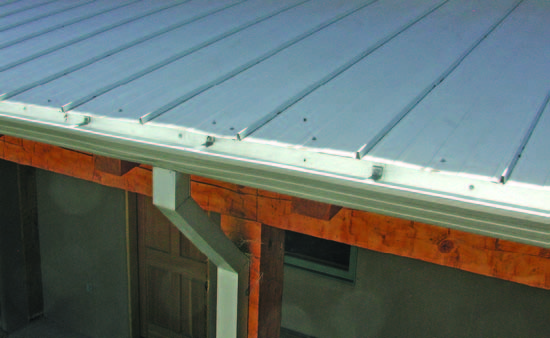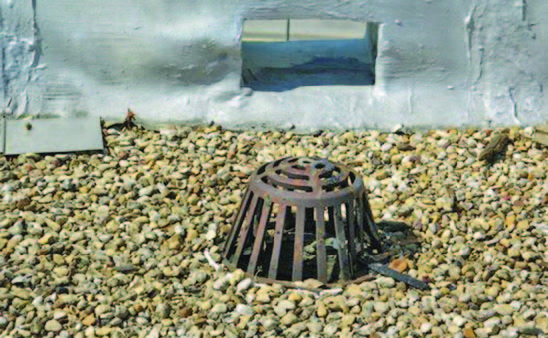The PermaDesign Weblog, with Nate Downey and Melissa McDonald!
Roof-Reliant Landscaping™ Step 16A: Water Conveyance - Concentration
Conveyance systems move roof water from precipitation collection surfaces to cisterns. In a roof-reliant landscape, a typical conveyance system will perform five functions:
1. Concentration
2. Vertical drop
3. Horizontal run
4. Filtration
5. Delivery

Figure 8-1: Gutters collect water from a pitched metal roof.
Conveyance begins where roof water is first concentrated in specific places, such as in a roof gutter, a canale or a roof drain. All concentration points require regular monitoring and occasional maintenance.
Gutters, which are almost always associated with pitched roofs, are open channels, or troughs, that direct roof water along roof lines usually toward downspouts. Typically, gutters are made of either aluminum or galvanized steel; custom-made copper and stainless steel gutters are also available at a higher cost. A common size for residential applications is a five-inch-wide gutter that drops a minimum of one inch for every 16 feet of roof line (1/16 inch per foot of slope).11 A gutter with more slope can handle a greater volume of water. Wider gutters are also available, and these are recommended for use in many steep roof and commercial applications.
Since gutters can require maintenance, be prepared to climb a ladder to clean out debris from time to time. If your building is situated next to one or more mature trees, you will likely have to remember to clean your gutters every fall. If you do not have mature trees in your current landscape, you may not have to clean your gutters for years, although annual monitoring would still be wise.
A canale is a short, narrow trough that protrudes through the parapet of a flat roof and directs water onto the ground below. A typical canale, according to the City of Santa Fe building code, should not be responsible for draining more than 400 square feet of roof. Canales on the north sides of roofs (especially northeast corners) should be avoided because the parapet can shade them during the shortest days of the year, which can cause ice blockage and freeze-thaw damage.
Before water harvesting became popular, an architect (or builder) could place canales virtually anywhere (except over a walkway or patio) as long as the precipitation never puddled on the roof. However, if you plan to include roof-reliant landscaping in your new construction project, it pays to let your architect and/or builders know this so they can most efficiently place the canales. It is much easier and less expensive to locate canales near your cistern instead of on the opposite side of your house.

Figure 8-2: Photo of a roof drain. Note the canale opening, which is required for secondary drainage.
Roof drains are sometimes used on flat-roofed buildings. These drains are typically connected to pipes fitted within the wall of the structure. Roof drains, as shown in Figure 8-2, can work well if properly designed, installed and maintained. (For more information, see the “In-Wall Drainpipes” section later in this chapter.)
However, expensive mistakes can result if any one of the three links in the designer-builder-owner chain is weak. If the designer underestimates the size of the drain, the roof may not be able to withstand the inevitable backup of water. Similarly, if the builder makes a mistake during construction, leaks can occur inside the walls of the building, and these can be difficult to detect. Additional problems with roof drains can occur whenever regular monitoring, cleaning and maintenance of the drain are neglected.
01/21/2016 | (0) Comments










Comments